May 19, 2022
From the Vault: ATHENE, Part I
A One-Off Cruising Cutter's Origin Story
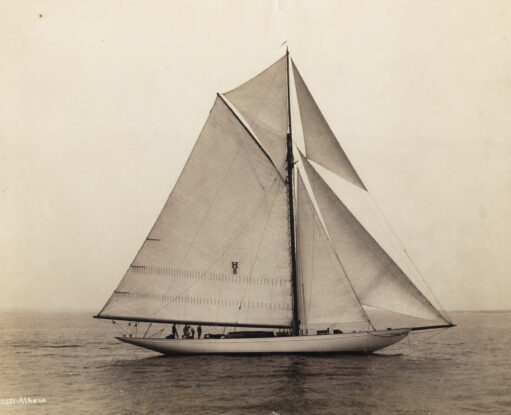
Introduction
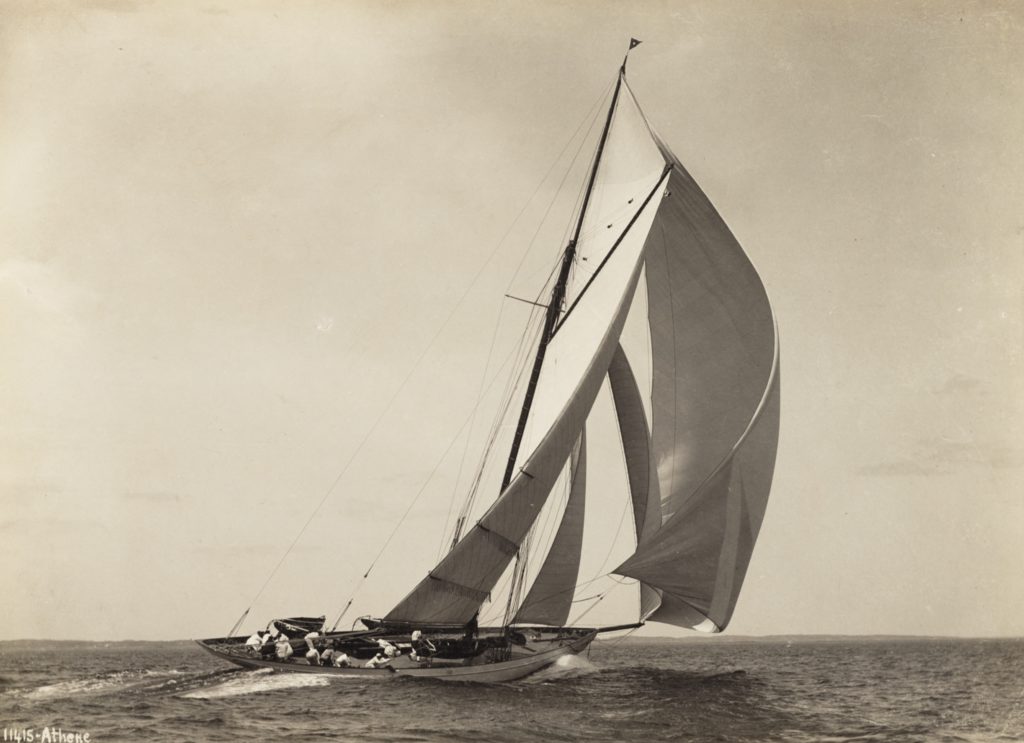
Here at HMM we are making an effort to highlight some of the lesser-known classes and individual vessels - not because they were unsuccessful designs or historically insignificant, but often simply because examples of them no longer exist, and so their stories are recounted less often. We are also gaining access to more material from collections both public and private relating to the individual design histories of many of these boats, and it is part of our mission to help the public better understand and benefit from that process as well. ATHENE (HMCo. #520) is a fairly typical example of Captain Nat's design process of this era, and went on to have a long and fascinating career. She therefore makes for a great case study of the process and an excellent opportunity to illuminate a perhaps lesser-known piece of HMCo. history.
The Design Brief
ATHENE was commissioned by the New-York-and-Boston-based banker and yachtsman William O. Gay. Gay was associated with the Beverly Yacht Club and the Knockabout Association. He was a friend of significant HMCo. patron Bob Emmons and, by 1899, a returning HMCo. customer himself: Gay also owned the 1897 21’ knockabout FLY (HMCo. #485) and the 1898 raceabout JILT (HMCo. #493 - now in the HMM collection). The 1899 ATHENE, though, was a different animal. This 106’ LOA, 70’ LWL composite keel/centerboard cutter was designed as a cruising vessel from the start. This was atypical for a period when HMCo. was very busy producing America’s Cup defenders, the first run of Buzzards Bay 15s, a few knockabouts and lots of 21’ waterline raceabouts, the last of the most extreme fin keelers, and a handful of small tenders and sailing dinghies - in short, mostly sailing vessels that were racing yachts first and cruisers second, if at all. (PETREL, HMCo. #510, is another notable exception in addition to ATHENE from this same year.)
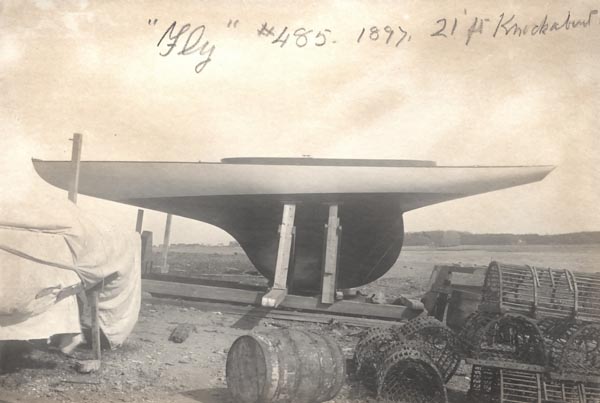
N.G.H. and Gay had corresponded previously about racing rules for the 21-foot classes, possibly in connection with FLY and JILT, but his first recorded visit to HMCo. doesn’t appear in Captain Nat’s diary until February 25, 1899. After an initial conversation presumably discussing general specifications, Captain Nat rolled up his sleeves and got to work. On February 28, he sketched a first draft of a pencil-on-paper interior layout and a preliminary sail plan. Interestingly, the initial proposal was for a schooner rig, not the cutter rig they settled on. The rig seems to have been a serious variable at this point: on March first, second and third, six more drawings were completed in quick succession with alternate proposals for a schooner, a cutter and a yawl rig. Some were inked on starched linen or paper, indicating blueprint copies could have been made for the prospective owner to review. (A pencil sketch is too light to be reproduced through blueprinting.) All of these drawings and one blueprint of one of the schooner rigs survives with the ATHENE drawings in the Model Room today.
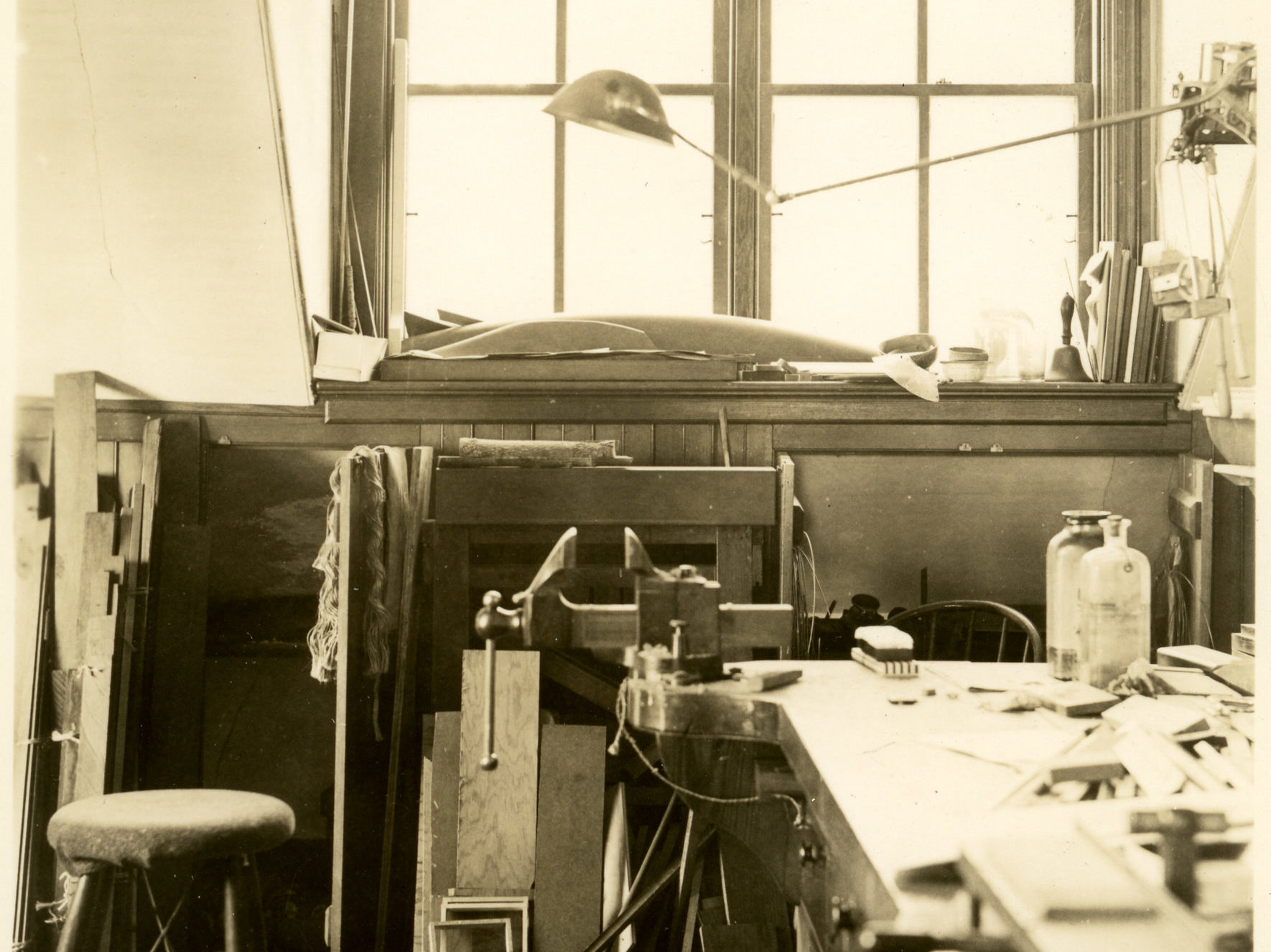
Gay returned to HMCo. on March 4th, according to Captain Nat’s diary, and this time N.G.H. explicitly noted in his diary that the conversation related to a “70 ft [waterline] cruising yacht.” One straggler inked schooner rig drawing was produced on March 15, and Gay returned for another visit despite rain and snow on March 18. No further drawings were produced between the 18th and March 23, at which point all parties were evidently satisfied: Gay signed a contract for a composite cutter to be built at HMCo. for the princely sum of $27,125.00 on March 23, 1899. Now it was really time for N.G.H. to get to work on the design. The rig, general dimensions, material and outfit specifications would have been agreed upon in the contract. It's possible the three little tenders ATHENE ended up with in 1899 were in there too, though the original contract is not known to still survive. (Any ancestors out there, we would love to hear otherwise!)
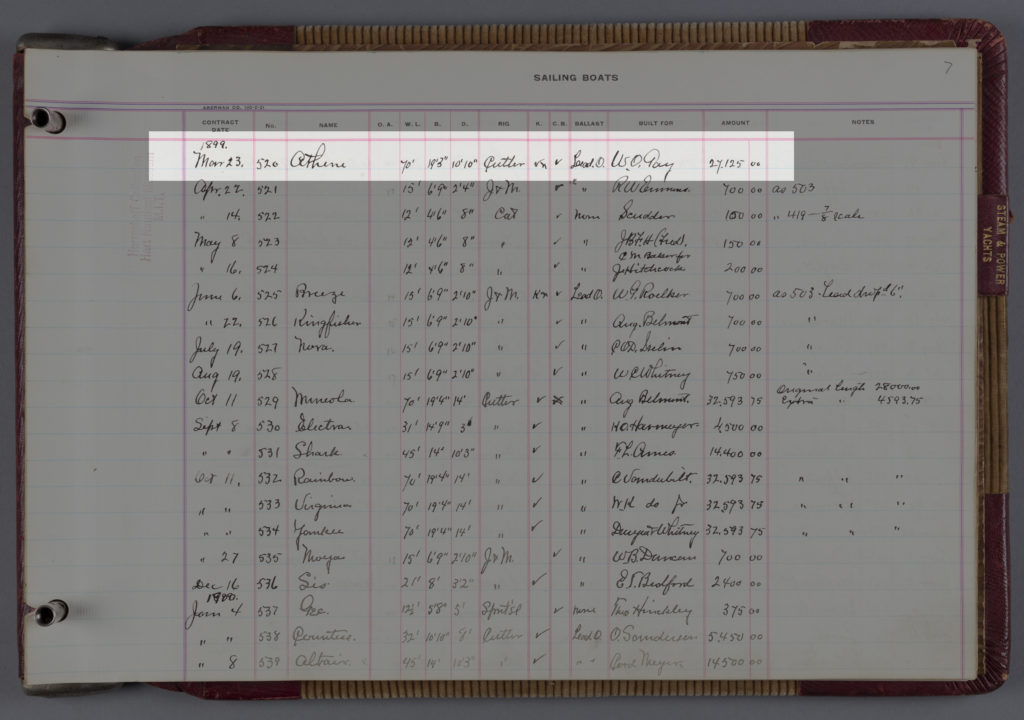
A Vessel Takes Shape

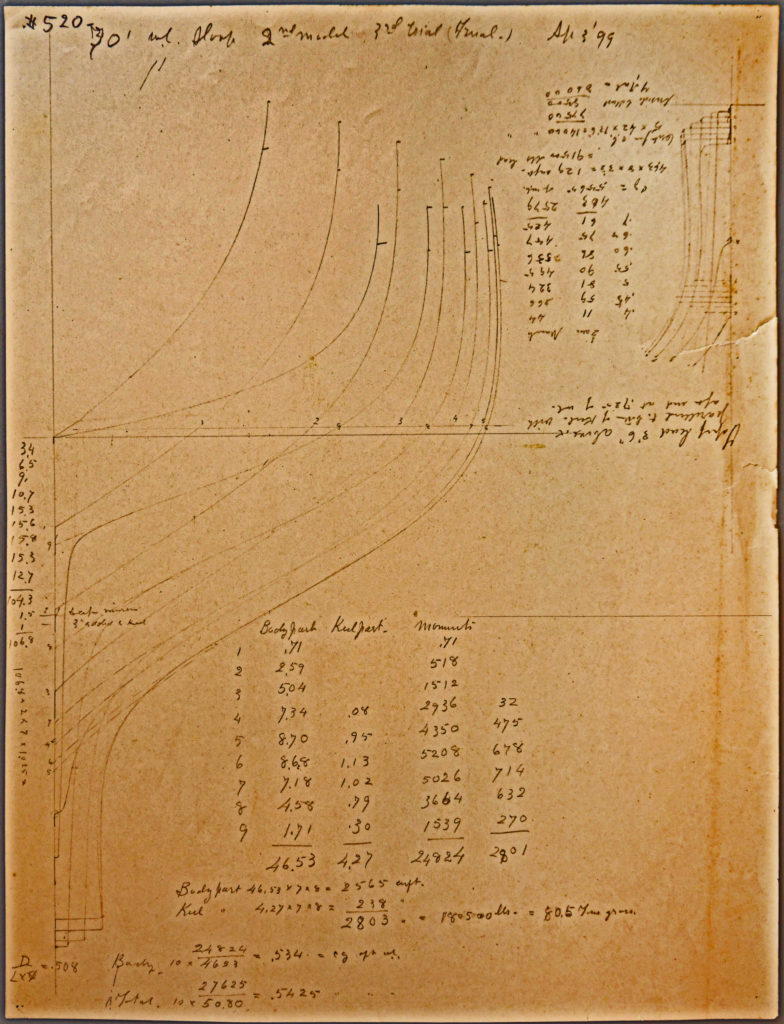
After agreeing on the general parameters in the contract, the next step was to refine the shape of the hull. For Captain Nat, this always began with a trip to his shop on the third floor of his home, Love Rocks, to work on carving the half model. While many extant N.G.H. half models are annotated on their reverse sides with useful things like contract numbers and dates, ATHENE’s model is annotated - but does not include the model completion date. ATHENE was the only vessel built to this particular model, and the back shows only the contract number (#520), vessel name (ATHENE), scale (1/2” to 1’) and the launch date, suggesting it may have even been annotated after construction was complete and the boat was delivered. While the exact date that the final model was completed is unknown, we do know a first model was finished enough to merit initial measuring by March 27 - just four days after the signing of the contract - because pantograph sections taken from the model on that date survive in the N.G.H. Model Room collection. Captain Nat was apparently not satisfied with this first shape and on March 31 another set of pantograph sections are labeled as having been traced from a second model. At this point, Captain Nat was near enough to his final hull shape that he set down the general specifications and contract number in his design and memoranda notebooks on April 2, as was his method when closing in on a new design. Generally these primary vessel pages in the design notebooks record the basic contract specifications and also were the place where Captain Nat worked out a new design's hull and fitting weights, then ballast and their centers, as well as displacement. Interestingly, there is a note on ATHENE's primary page indicating that the model was still unfinished at this point (April 2). This note is supported by yet another set of pantograph sections dated April 3rd titled “2nd model, 3rd trial,” indicating he had continued to re-carve the model between section trials by pantograph to analyze the shape further. The April 3rd pantograph sections are presumed to be the last set, and would be the closest shape to the offsets if we were to compare them today, provided no later pantograph recordings were made and lost. (Comparing the offsets to the half model on the other hand would be an interesting experiment, and may not produce the same results: it was not an infrequent occurrence that Captain Nat might return to measure a half model years after it was initially carved, and comment that the wooden model had shrunk. RESOLUTE's model - HMCo. # 725, the 1920 Cup defender designed and built in 1913-1914 - is one notable example.)
When Captain Nat was satisfied with the shape of the model and his calculations using the pantograph sections, he would have proceeded to record the model's offsets in a small notebook using the offset reading machine now on display in the N.G.H. Model Room & Workshop at HMM. Next the offset booklet would probably have gone across the street to the drafting office (or perhaps the mold loftsmen fought the draftsmen for first crack at them, depending on the build and whether it was composite or all wooden construction). ATHENE’s offsets do survive in the MIT collection, but they are simply dated “April 1899”. Though the specific day was not recorded on the offset notebook, it had to have been between April 3rd - the last pantograph trial - and April 12th at the very latest.
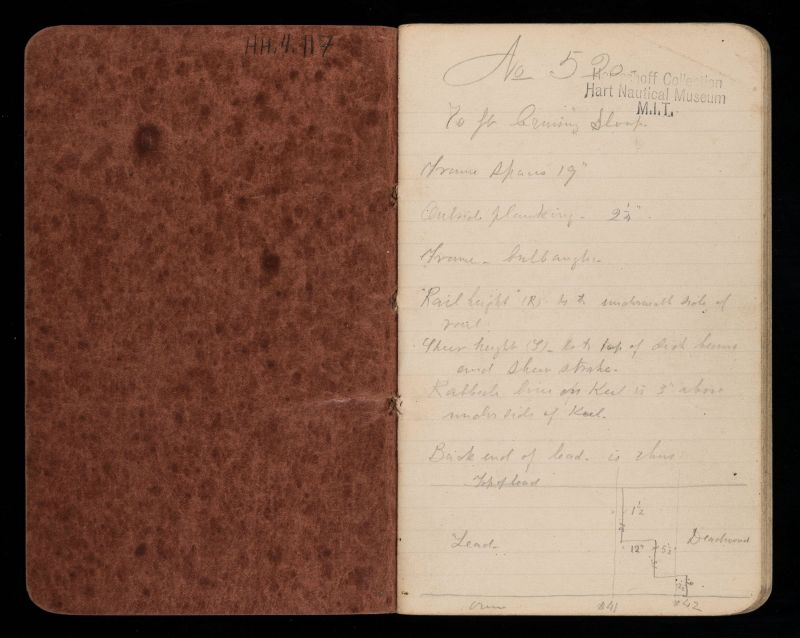
Captain Nat worked out the lead calculations on the final pantograph sections on April 3rd, and by April 10th they were recorded in the design notebook. April 10th was also the same day he produced a set of pantograph recordings of the keel and a card stock cut-out of the lead profile with a pinhole circled - evidence of a balancing test. Just two days later on April 12th, Captain Nat noted in his diary that the mold for the lead was taking shape in the shop (hence the outside date on the offsets, which would have been necessary to create the mold for the keel). The keel would have been one of the first steps in construction in this particular build. ATHENE was a composite boat (steel frames, wooden planking) built right side up, meaning the hull had to set on the keel as a foundation from the start. This stands in contrast with the Herreshoff method for smaller all-wooden boats up to 50’ on the waterline, where the hulls were framed and planked upside down before being turned upright and set on their keels. With these smaller all-wooden vessels, the keels could have been cast later in the construction process, while the hull was already being planked.
Construction Begins
According to both diaries and notebook, the lead was cast on May 12th, exactly one month after the mold construction began. At nearly 42 tons of lead, the casting process took 5 3/4 hours, according to Captain Nat’s diaries. Around this point, Gay was either confident enough to begin talking to the press, or there was a leak somewhere in his inner circle: the Boston Globe reported on April 23rd on interior details that could only have come from firsthand knowledge of the proposal from February, or from the contract itself. A little late to the game by comparison, the Bristol Phoenix got wind of the project five days later in a general sense, writing on April 28: "... Work has just been begun on a large sloop yacht for a member of the New York Yacht Club, whose name is not made public. She will be 70 feet on the water line and will be a centerboard craft. She is designed for comfortable cruising, rather than speed, though Herreshoff creations are never slow, and will be strongly built with high sides and ample cabin room..."
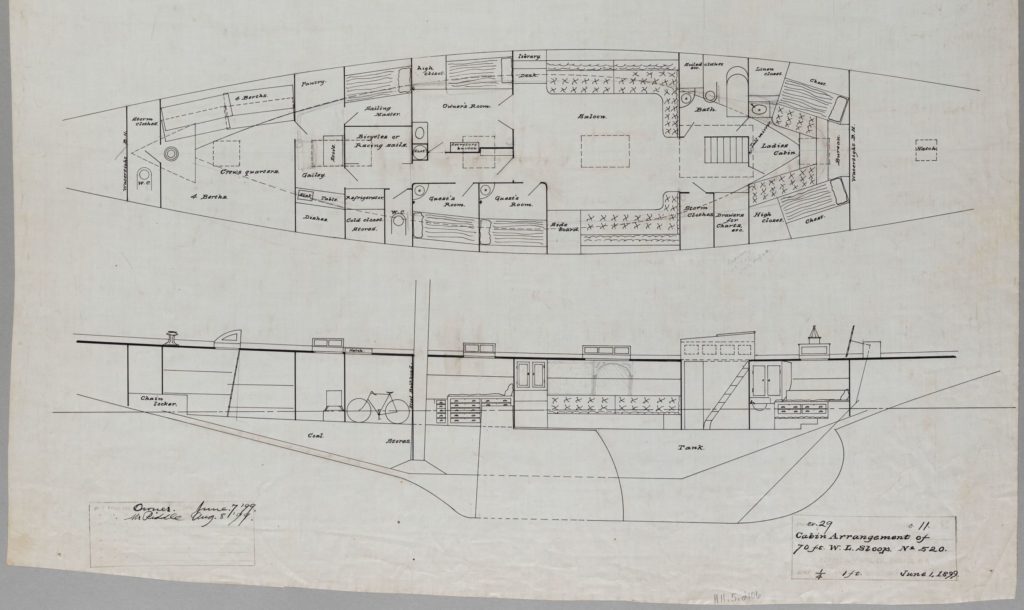
Keeping One Step Ahead
While the keel was in the process of being poured, plans were being laid to order the material necessary to build the rig: a list of sails and material needed was drawn up on April 15. Between May 16 and 20, Captain Nat drew up lists of sizes and lengths of material for the wire elements in the rig, and a list of running rigging and blocks. A work order on May 24 indicated the galvanized plow steel rope from the Hazard Manufacturing Company would be wanted by July 1. The drafting shop was being kept busy with what would amount to almost 100 initial drawings covering every detail onboard. Some of these drawings (most of which are now in the collection at MIT) are undated, but the majority of them pertaining to hull construction date between April 16 and May 31. By the end of June, the drafting department had moved on to hatches and skylights and some elements of the rig. July and August were mostly occupied with the interior arrangements and more of the rig. Hardware was set down on paper in September and the endless rig planning carried on. The last drawing from the first run is, fittingly, a hinge for the companionway ladder dated November 25, 1899.
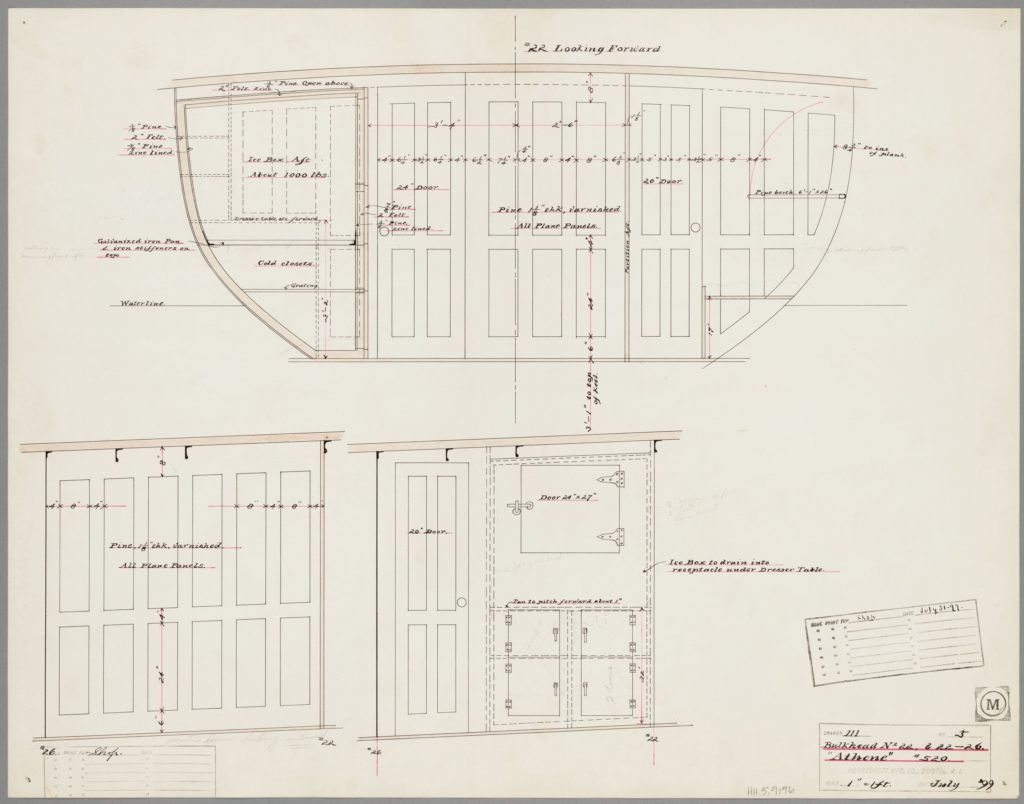
We don't know exactly what was going on in the shop day by day, as that step of the process is the least well-represented in extant archives, but basic construction logic and the dates on the drawings give us a pretty good indication. A careful analysis of the blueprint tracking block on the construction drawings - when blueprints were made and for which shop, and sometimes, when they were destroyed - could certainly help get us get closer, but that's a project for another rainy day. While the drafting office was keeping ahead of the construction shop every step of the way throughout the summer and early fall of 1899, Captain Nat was keeping busy with - among a few other things - the Cup defender COLUMBIA (HMCo. #499). COLUMBIA was launched on June 10, 1899 and had been under construction since January 1899. DEFENDER (HMCo. #452) also returned to HMCo. during this spring to be readied for trials against COLUMBIA that summer, and to be rigged and re-rigged.
A Slight Distraction
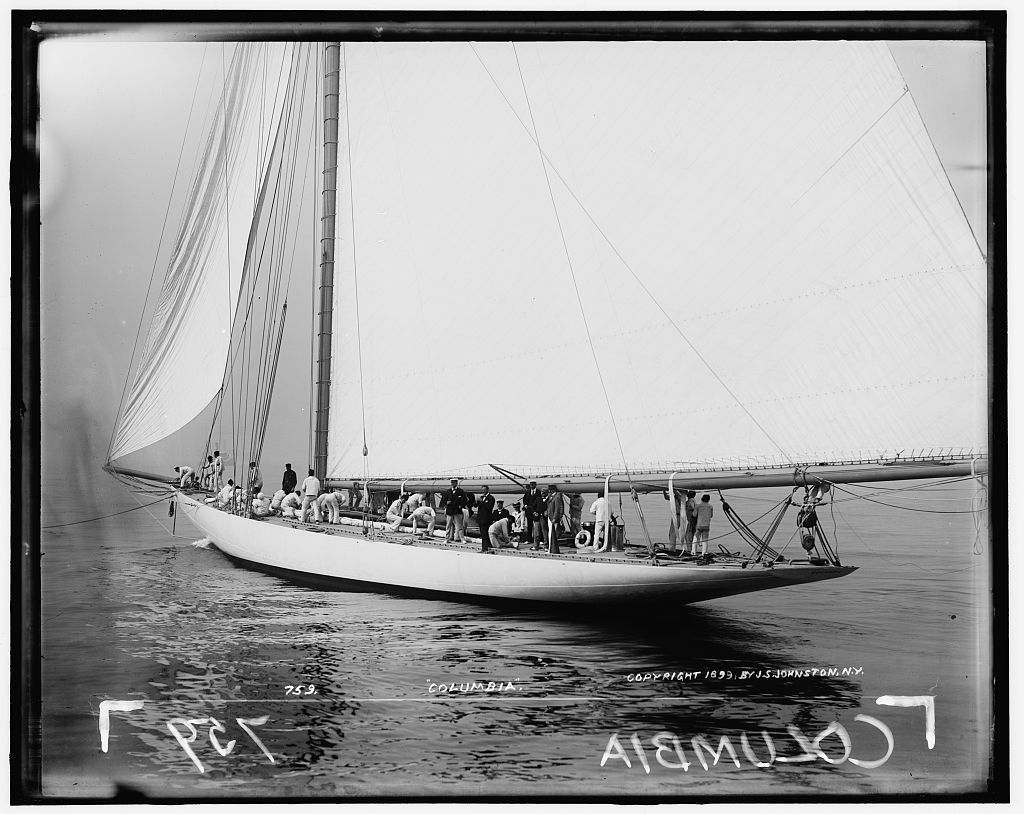
While ATHENE's hull was nearing completion, the Cup races were slated to take place the first weeks of October. Captain Nat went down to New York for the series on September 30th. The weather gods were unkind however, and it took seven attempts before there was enough wind for the first race! On October 6th, J.B.H. sent N.G.H. a telegram from Bristol letting Captain Nat know that ATHENE’s launch had been delayed to Monday (October 9). N.G.H. traveled home to Bristol on the 7th, attended ATHENE’s launch on the 9th, and returned to New York that same day to continue to attend to the Cup defense. COLUMBIA prevailed on the 20th of October, and Captain Nat took a midnight train home to Rhode Island that very evening. Despite the whole town of Bristol turning out to celebrate Captain Nat & HMCo.’s successful Cup defense with parties and fireworks, N.G.H. noted the very next day (October 21) that ATHENE was nearly ready for trials - and on the evening October 22, ATHENE departed for Marblehead and her new life. Captain Nat reported in his diary that he was onboard for a satisfactory trial during the run down the Bay, which also served as the first leg of the delivery. No rest for the weary!
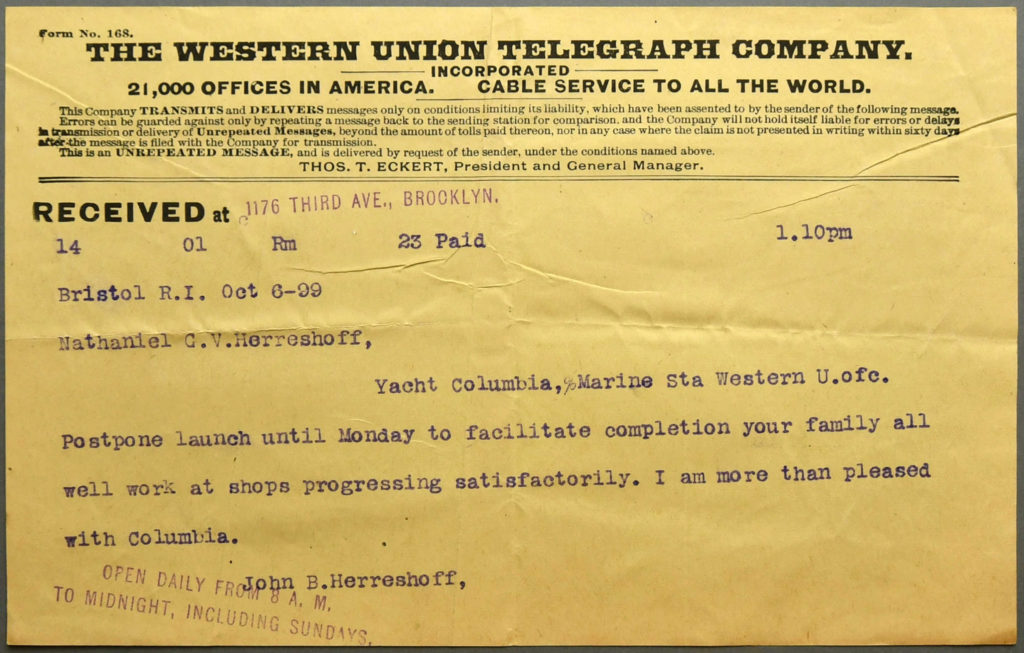
Beginning Again
Just two weeks later on November 3rd, 1899, the shop cast the lead for MINEOLA (HMCo. #529), the first New York 70... and so the construction cycle was in motion again, this time with four comparably sized vessels. Actually, the cycle had already been underway for some time: all four contracts for the NY70s had been signed on October 11th - perhaps while the owners were all in New York also watching the Cup races? - which meant that as with ATHENE, N.G.H. would already have been weeks or even months into discussing the vessels’ particulars with the owners, and the design process had to have been fairly complete by the time the keels were cast. And this was done all while keeping up with the Cup defense, and the constant stream of 15s, raceabouts, launches and tenders exiting the shops at a steady pace...
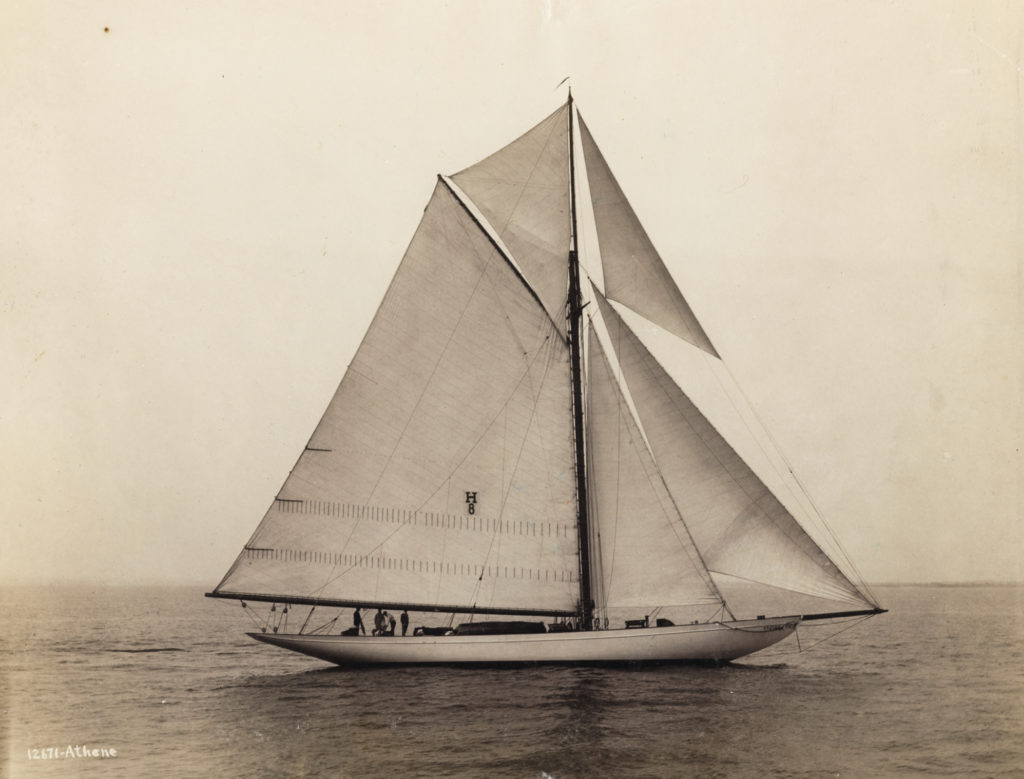
It is truly staggering to consider how many levels of production were perpetually in motion across all departments at HMCo., and ATHENE is just one small slice. So went the days and years at HMCo. in this remarkable partnership between the two brothers - and supported by hundreds of critical individuals. Much research remains to be done about the people who enabled the machine that was HMCo. to carry on in this way: draftsmen, shop foremen, builders, riggers, sailmakers, crew members, night watchmen, suppliers near and far, and their families and the local community that was their home - so here's hoping more archival material continues to come to light as more collections come online, and the study may continue!
Join us again next month for Part II - The Rest of ATHENE’s Remarkable Life!
This piece is for Maynard Bray. Access to the MIT Museum Collection, the Halsey C. Herreshoff Collection and the Historic New England Stebbins Collection and the Library of Congress Detroit Publishing Collection are gratefully acknowledged; without them we would not be able to draw these threads together. With the exception of the design notebooks, all primary resource documents referenced in this post are indexed in the extraordinary Herreshoff Catalogue Raisonné - click here to explore ATHENE's page further - as accessed May 19, 2022. This piece would not have been even remotely possible without the Herculean and decades-long efforts cataloging, collecting and organizing data undertaken by the creators of the HCR.
